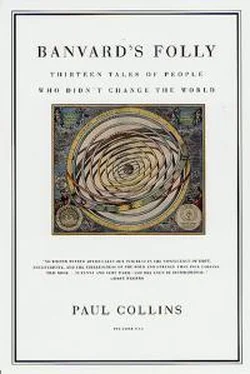Readers of the July 19, 1861, issue of the London Mechanics Magazine were treated to this description of the strange goings-on by the Thames riverside: On Wednesday last some experiments, on a rather large scale, were made on the right bank of the river ... with a view to testing the efficiency of the novel mode of transmitting goods and parcels. The mechanical arrangements in connection with the experimental line of cast iron tubing--which, like a huge black snake, stretches for more than a quarter of a mile along the river side--are few and simple. It was, like Beach's subway, essentially a giant peashooter. This straw was a yard high and built of cast iron, the pea weighed about half a ton, and the breath propelling it was a giant pneumatic ejector fan spinning at 200 rpm.
The carriages, low-slung and rather sporty-looking, stood less than three feet high--far too short for passengers. But the directors of the Pneumatic Dispatch Company gathered at the riverside that Wednesday watched with satisfaction as workers loaded a carriage with one ton of cement bags. The carriage was pushed into the end of the tube, the hatch shut with a clang, the signal given, and--whoosh--fifty seconds later a ton of metal and cement came banging out the other end, a full quarter mile away.
The company directors were delighted.
More tests were run, with the little carriages merrily zooming back and forth through the tube, around sharp curves and up and down steep grades, every time without a hitch. The crowd watching all probably had the same thought by now: Who will ride in it?
And then their eyes settled upon, in the rather unkind words of Mechanics Magazine, "a living passenger in the shape of a dog, not very handsome." The hapless pooch was tossed in along with some bags of cement and sent rocketing off. Word came back from other end--the dog was fine. Now the real question came up. Would a man climb in?
It being London, there were a couple of likely lads happy to oblige. A mattress was thrown into a carriage, a saddle blanket found to tuck in the adventurers, and in they went, lying flat on their backs and staring up at the sky. The carriage was rolled forward and enclosed in the utter darkness of the iron tube. The signal was given and, with a mighty blast of air, the two felt themselves thrown forward.
Fifty seconds later the two emerged at the other end, the lucky recipients of a bizarre joyride. But the company directors watching had more than amusement in mind. They now knew their tube could carry mail, heavy cargo, even passengers--and it could carry the Pneumatic Dispatch Company all the way to the bank.
Pneumatic Transit had been tried even before then. In 1810, the London inventor George Medhurst published a curious pamphlet titled A New Method of Conveying Letters and Goods with Great Certainty and Rapidity by Air. Using air forced through a tube, Medhurst thought, goods could be shot along at up to 100 mph. Soon he expanded his vision to passenger lines, and he spent the next two decades perfecting his ideas, at one point issuing shares for the building of an atmospheric railway line. He had few takers.
Others followed, though. In the 1820's and 1830's, John Vallance and Henry Pinkus both took cues from Medhurst's later work and developed passenger railway designs that kept the compressed air but dispensed with the all-enclosing and claustrophobic tubing: instead, their tubes of compressed air would be built into the trackway, with the carriage riding atop it in the open air. Pinkus even claimed that farm plows could be driven by laying these pneumatic rails across fields. Vallance managed to attract the attention of officials from the Russian embassy, who examined his designs with a view toward building their own atmospheric line from St. Petersburg to the Black Sea.
But these inventors were far ahead of the public's imagination and the technology of their day. Both floated stock to finance their designs, and both went home empty-handed. By the 1840's, though, there were enough improvements in these open-air designs that investors started taking more notice. One inventor built a working model across a London cricket pitch. Not too far away, near Wormwood Scrubs Prison, another team of inventors built a full-scale experimental rail line that carried seventy-five passengers and could reach 40 mph when empty.
There was a boom in atmospheric railway building for the next few years, and for good reason: the trains were quiet and clean, and they could stop and start with astonishing speed. One unwary tester on a Dublin atmospheric line accidentally hit 84 mph, which may well have made him the fastest man on earth for a time. Lines were built in France, Austria, Ireland, and England. Stock offerings were legion, and in England extensions were planned all the way down to Cornwall.
But the system remained a bit dodgy. The materials at hand just weren't reliable enough: air pistons leaked and cracked in the cold, and rats nestling in them were shot out like furry bullets as the train approached. Many designs only allowed trains to go in one direction at a time, so that if a train overshot a station, all the passengers had to get out and push it back to the platform. Tracks could not be merged or crossed. Worse still, the compressors of the day lacked sufficient power for long rail lines. Timetable inspectors found that breakdowns were a constant problem on some lines, and--most humiliating of all--sometimes a steam locomotive had to be hauled out to do the job. By the late 1840's, investors had decidedly had it with atmospheric rail.
Population densities in London, Paris, and New York became intolerable in the 1860's; city planners knew they needed to expand outward with worker housing, but they lacked transportation for a daily commute to work. In the meantime, downtown street traffic was becoming increasingly dangerous and grindingly slow.
Amid these traffic jams, surface rail lines looked less appealing now, at least inside cities, and so attention naturally turned to subways. But coal-fired locomotives, which spewed cinders and smoke into passenger compartments even aboveground, were doubly undesirable in a confined tunnel system. Inevitably, the massive propeller blades of pneumatic motors began to turn once again--and now, thanks to engineering developments during the 1850's, they could spin in reverse, so that cars could be pushed forward and pulled back within the same tube. Telegraph offices in London started installing small-bore tubes to send messages from stock exchanges to central telegraphy offices, and by 1858 there was over a mile of tubing under London.
Large-bore tubes for cargo and passengers were the next logical step.
After the success of the Battersea line, in 1863 the Pneumatic Dispatch
Company built cargo lines in London for the post office, including a half-mile pipe from Euston Station to Eversholt Street; by 1865 the company had extended it another two miles, through Tottenham Court, New Oxford Street, and finally to the central General Post Office at 245 Holborn Street. It was not unknown for workers to take joyrides in the mail carriages, getting shot through a massive iron tube across two and a half miles of metropolitan London in a matter of a few minutes. The Duke of Buckingham, who happened to be the chairman of Pneumatic Dispatch, was fond of personally showing off his thrill ride. One pneumonaut recalled:
The sensation at starting, and still more so upon arriving was not agreeable.
For about a minute in each case there was a pressure upon the ears suggestive of a diving-bell experience, a suction like that with which one is drawn under a wave, and a cold draught of wind upon the eyes, having almost the effect of falling water.
But as long as the passengers kept their heads down, no one seemed to be worse for the experience. Frank Leslie's Illustrated Newspaper announced that
Читать дальше











